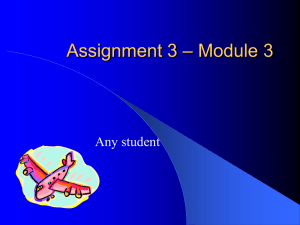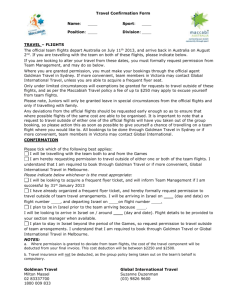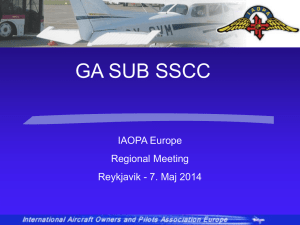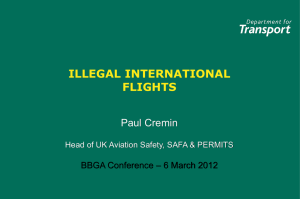Facts and Figures - Ministère de l'écologie, du développement
advertisement
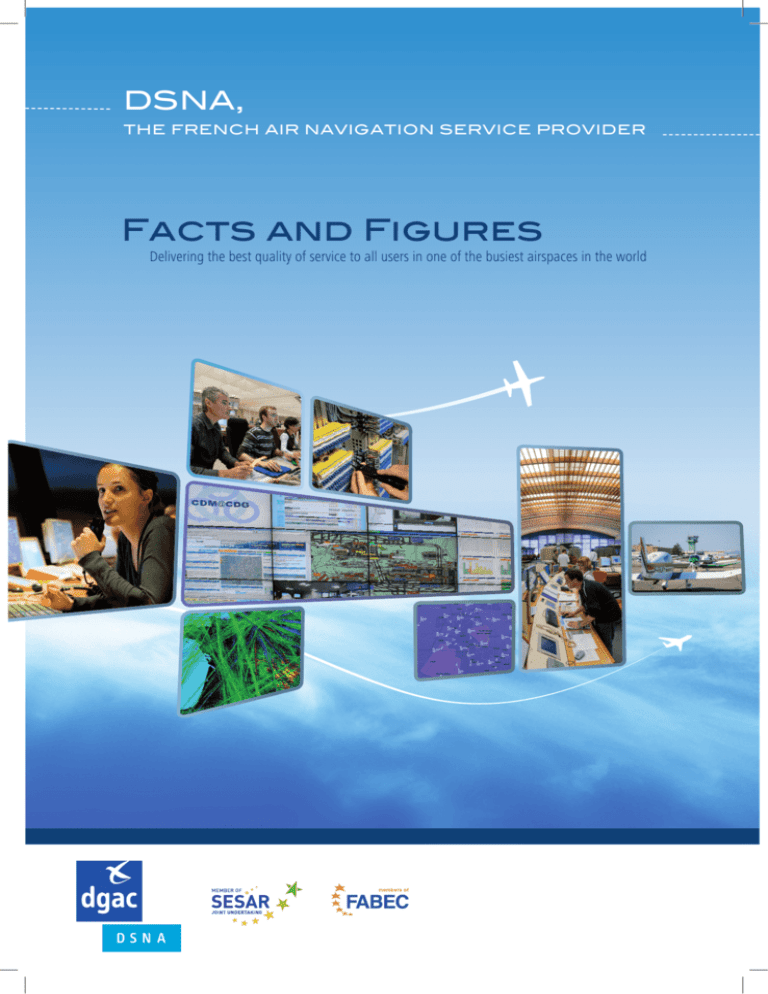
DSNA, the French Air Navigation Service Provider Facts and Figures Delivering the best quality of service to all users in one of the busiest airspaces in the world air traffic 2 Due to its size and position at the crossroads of the major European air traffic routes, France along with Germany is the country that controls the most flights in Europe. Over the past 30 years, the capacity of the French Air Traffic Control System has increased three-fold with traffic of nearly 3,000,000 flights a year. French controllers handled a one-day peak of 10,018 flights on 11 July 2008. Air traffic controlled by France is subject to high seasonal variations with 49% more flights per day on average in July than in January. In 2011, the French air navigation services controlled 7,860 flights per day, with 72 days of more than 9,000 flights per day. Annual IFR Flights and Medium-Term Forecast Breakdown of Monthly IFR Flights 3,200,000 300,000 3,000,000 280,000 260,000 2,800,000 240,000 2,600,000 220,000 2,400,000 200,000 2,200,000 2,000,000 180,000 2006 2007 2008 2009 2010 Source: Eurocontrol 2011 2012 2013 2014 2015 160,000 JAN FEB MAR APR MAY JUN JUL AUG SEPT OCT NOV DEC Low-Growth Scenario 2001 2008 2011 The 13 largest airports in 2011 1. 2. 3. 4. 5. 6. 7. 8. 9. 10. 11. 12. 13. View from Paris-Orly control tower. Paris-Charles de Gaulle Paris-Orly Nice-Côte d’Azur Lyon-Saint Exupéry Marseille-Provence Toulouse-Blagnac Basel-Mulhouse Bordeaux Paris-Le Bourget Nantes-Altantique Lille-Lesquin Montpellier-Méditerranée Strasbourg IFR movements (arrivals/departures) 514,000 232,000 137,000 121,000 105,000 99,000 73,000 60,000 59,000 50,000 39,000 38,000 30,000 Paris-CDG and Paris-Orly represent 46% of IFR movements in France; the 6 first commercial airports represent 73% of IFR movements. 3 DSNA (Direction des Services de la Navigation Aérienne), the French Air Navigation Service Provider, operates five en-route control centres (ACC) and nine mainland regional structures (SNA) for approach and aerodrome control services, along with three overseas regional structures. The airspace of mainland France and Corsica covers 1 million km². The breakdown of air traffic controlled in France is as follows: 45% are overflights, 39% are international flights to or from France and 16% are domestic flights. ACC SNA Headquarters UNITED KINGDOM THE NETHERLANDS BELGIUM European overflights: average number of daily flights in 2011 GERMANY 432 Lille International departures and arrivals: average number of daily flights in 2011 370 Lille Reims Brest Reims Strasbourg Strasbourg Brest Paris Nantes 599 Paris Basel-Mulhouse Nantes 215 219 Lyon Bordeaux Lyon Aix-en- Bordeaux Montpellier Provence Toulouse Aix-en-Provence Toulouse Nice Marseille 306 302 Marseille Nice ITALY 426 International flights Overflights SPAIN 359 280 45 % 39 % 16 % AFRICA Paris ACC operations room (1,300,000 IFR flights per year) Domestic flights QUALITY OF SERVICE 4 Flight safety and security Flight safety remains the core activity of DSNA. An integrated management system has been implemented which covers safety, security, quality and environmental aspects, thus ensuring global consistency while efficiently managing resources. Indicators used to measure safety level • for en-route control: - HN 70 (two aircraft are separated by less than 70% of the standard): 0.98 of losses of separation per 100,000 controlled flights in 2011 - HN 50 (two aircraft are separated by less than 50% of the standard): 0.10 of losses of separation per 100,000 controlled flights in 2011 • for approach control: 9 airspace infringements by IFR flights leading to inadequate separations in 2011 • on airports: 211 runway incursions in 2011 (75% involving an aircraft, 20% vehicles and 5% people). Performance management: DSNA plays a proactive role in the creation of European safety indicators such as the Efficiency of Safety Management System and the use of the Risk Analysis Tool. In addition, DSNA promotes a “Just Culture” approach in all its operational units. Reducing the environmental impact of air navigation Reducing the impact of air navigation on the environment comes right after safety and security. DSNA continuously improves air traffic procedures and controller training to deliver environmental benefits in close cooperation with elected representatives, associations and local residents. Indicators: • Horizontal en-route flight efficiency: the average horizontal route extension from TMA to TMA is 2.8% • Deviations from the environmentally protected volumes at Paris-CDG and Paris-Orly airports: 23 in 2011 The “Grenelle de l’environnement” Paris TMA redesign: in order to reduce the noise of all incoming aircraft to the 3 main airports in Paris, the altitude of all arrival procedures was raised (300 metres) in November 2011. The number of people exposed to noise events of 65 dB (NA65) was reduced by 60%. Continuous Descent Operations (CDO): procedures were published for 6 major airports as planned in the FABEC performance plan. The average delay due to air traffic regulations The average delay due to air traffic regulations for the decade [2001 - 2010] in France was 1.21 minutes per flight. Punctuality of flights is a very sensitive indicator of conjectural factors. The poor result achieved in 2010 was attributed to industrial relations issues. In 2011, it was of 0.67 minutes per flight. Punctuality of commercial flights at take-off Breakdown of causes of delays (15’ or more) Period: 2001-2010 3 31% Reactionary delays 2 Flights on time 1 0 2001 2002 2003 2004 2005 2006 2007 2008 2009 2010 2011 Breakdown of ATFM delay in 2011 Minutes of delay Minutes per flight Air Traffic Flow Management (ATFM) delay 500,000 0 Airports - Security (12%) 14% & Customs Service (2%) 0% Passengers 1 5% Weather 2,000,000 1,000,000 27% 28% Airlines 12% Air Navigation 2,500,000 1,500,000 73% Delayed flights ACC (63%) Airports (37%) The French air navigation services were responsible for 12% of these delayed flights. SUPPORT 5 Human Resources Staff in DSNA Mainland France and Corsica Overseas Territories Total Staff by department Headquarters Operations Directorate (DO) Technical and Innovation Directorate (DTI) Pacific Overseas Territories 7,267(93%) 579 (7%) 7,846 126 (2%) 6,971 (88%) 530 (7%) 219 (3%) Breakdown by staff groups Others groups 7% (562) Workers 3% (272) Office groups 6% (495) TSEEAC 14% (1,116) ICNA (ATCOs) IESSA 18% (1,388) ICNA 52% (4,013) Engineer-controllers with a valid licence: 3,658 (46% in ACCs) IESSA (ATSEPs) TSEEAC Maintenance personnel SNA: 724 (52%) ACC: 383 (28%) DTI: 167 (13%) Other depts.: 114 (7%) Senior technicians – controllers with a valid licence for small aerodromes: 306 (8% of all ATCOs) Finances: controlling costs and investing in the future DSNA revenue was 1,432 M€ in 2011. The annual financial accounts are certified by an accounting officer. Financial management is measured by a control process using targets and performance indicators. Breakdown of investments from 2012 DSNA Revenue in 2011 Mainland France and Corsica En-route charges Charges for air traffic terminal services (RSTCA) Overseas Territories Oceanic charges RSTCA charges Income excluding air navigation charges DSNA Revenue 1,155 M€ 227 M€ 11 M€ 28 M€ 11 M€ 1,432 M€ Investments (M€) Maintenance in operational conditions 30% 40% Investments 250 200 150 100 50 0 Major programmes preparing the future 30% 2007 2008 2009 2010 2011 2012 2013 2014 2015 Evolution of capacity ATM systems (new equipment) & modernisation of facilities SINGLE EUROPEAN SKY (SES) 6 One of the pillars of SES is the implementation of Functional Aispace Blocks (FAB). The FAB Europe Central (FABEC) includes 6 countries: France, Germany, Switzerland, the Netherlands, Belgium, Luxembourg, and 7 Air Navigation Service Providers: ANA, Belgocontrol, DFS, DSNA, LVNL, Maastricht ACC (Eurocontrol) and skyguide. To improve flight efficiency, free route will be implemented in the upper airspace using a step-by-step approach. Arrival management systems will be extended within a range of 200 Nm and the concept of Airport-CDM (Collaborative Decision Making) is in development for the main airports. FABEC airspace Amsterdam • 17% of ECAC area (1.8 million km²) London Frankfurt • 7 million flights by 2016 • 370 control sectors; 400 military/special areas Paris 35 • 14 area control centres; 1,8 1,780 km • 240 airports including some of the busiest in Europe; major airports are labelled “Airport-Collaborative Decision Making” FABEC • 17,700 civil staff Munich km Core Area Air traffic density and airspace complexity En-route Unit Rates in Fabec airspace Structural complexity 1.4 €100 1.2 1.0 Avinor Finavia 0.8 0.6 FABEC NEFAB NAV Portugal 0.4 NEFAB: North European FAB FAB “P-SP”: FAB Portugal/Spain LFV/ANS Sweden P-SP Aena €90 Austro Control €80 HungaroControl ATSA Bulgaria 6 8 €70 10 12 France €60 Traffic density Source: Eurocontrol FABEC is located in the heart of Europe. This is one of the busiest pieces of airspaces in the world. Collectively the 7 ANSPS of FABEC provide 28% hours IFR flights in ECAC area (DSNA: 13%, DFS: 8%, MUAC: 3%, skyguide: 2%, LVNL-Belgocontrol-ANA: 2%). €50 2008 2009 2010 2011 2012 2013 2014 2015 New SES II legislation contains the requirement to set up a performance scheme for air navigation services and network functions in the Key Performance Area (KPA) safety, environment, capacity and cost efficiency. The FABEC States have set up a performance plan for 2012-2014 that is complemented by a plan at the national level. WHO ARE OUR USERS? 7 Specifications Part of total IFR Flights in France Maxi Take-Off Weight Cruising speed Service ceiling Aircraft Seating capacity Powered The Airbus A320 Family (A318 to A321) 36% 68 to 94 T Mach 0.78 FL 390 107 to 220 Jet The Boeing B737 Family (B737-200 to B737-900) 21% 50 to 85 T Mach 0.74 FL 350 to FL 410 85 to 215 Jet The Embraer Family (135/145/170/190) 5% 19 to 53 T Mach 0.76 FL 370 to FL 410 37 to 122 Jet The CRJ Family (CRJ100/200/700/900) 3% 21 to 37 T Mach 0.78 FL 350 to FL 410 50 to 90 Jet The ATR Family (ATR 42/ATR 72) 2% 19 to 23 T 510 km/h to 560 km/h FL 250 42 to 74 Turboprop The five largest customers for DSNA 40% of DSNA income from air navigation fees is generated by five commercial airliners: Air France, Ryanair, easyJet, British Airways and Lufthansa. Paris-CDG airport Basel-Mulhouse airport Beauvais airport Paris-Orly airport Nice airport Air France easyJet Ryanair British Airways Lufthansa 17% 8% 8% 4% 3% The low cost-airliners carry 21% of French passenger traffic in France: esayJet and Ryanair represented 71% of this traffic in 2011. Breakdown of air navigation charges by type of services Charges in 2011 in Mainland France and Corsica Charges for en-route control services Total: 1,155 M€ French carriers 19% 81% Charges for air traffic terminal services (RSTCA) Total: 227 M€ Foreign carriers French carriers 52% 48% Foreign carriers Publisher: Maurice Georges – Editor: DSNA cabinet F. Richard-Bôle – April 2012 – Photographies: DSNA (S. Cambon, V. Colin, M. Bonini) et M.L. Lurois/ Beauvais – Layout: Allwrite – Printing: DSNA/SIA Direction générale de l’Aviation civile Direction des services de la Navigation aérienne 50, rue Henry Farman 75720 Paris cedex 15

